How to acknowledge MUSES code
If you use MUSES code or data in your research and publications, please include the following text:
This work was supported in part by the National Science Foundation (NSF) within the framework of the MUSES collaboration, under grant number OAC-2103680.Publication Policy for MUSES Collaboration
This document establishes the publication policy for the Modular Unified Solver of the Equation of State (MUSES) collaboration, which was initiated through NSF CSSI funding.
Definitions
This policy distinguishes between two types of publications: collaboration-wide publications and short-author publications.
Collaboration-wide publications are those that a simple majority (>50%) of the collaboration participates in. Topics covered by collaboration-wide publications include (but are not limited to) review-like papers, MUSES cyberinfrastructure deployment, and global analysis of data or physics that employs the calculation engine and multiple modules.
Short-author publications are those pursued by small groups of researchers (less than <50%) at one or more institutions. Topics covered by short-author publications include module release papers (e.g. the release of the CMF module that includes the equations, pseudocode, and benchmark checks), focused physics efforts that use the MUSES cyberinfrastructure (e.g. the Bayesian analysis anticipated from the holography code), specific module development papers, and analysis of data that employs only one or a few modules.
Policy
The publication policy of the MUSES collaboration is the following:
- All collaboration-wide publications will be authored by all members of the collaboration that have earned authorship status. The order of the authors in collaboration-wide publications will be determined by the MUSES executive committee.
- All short-author publications will be authored by the subset of the collaboration that has earned authorship status and that has participated directly in the research, including either physics research or computational development. The authors of short-author publications will be determined by the subset who authors them.
Authorship status is available to all members of the collaboration who demonstrate involvement in the development of the MUSES cyberinfrastructure. Members of the collaboration demonstrate involvement by contributing to the physics or the computational work of the cyberinfrastructure (either through calculations and coding or through advising), attending consistently at least one set of weekly meetings, and attending at least one collaboration meeting or summer school every 3 years.
For all papers, potential authors (be it collaboration-wide or short-author) will be given the option to opt out from authorship on a publication by publication basis. For short-author papers, when in doubt about the degree of participation of a given member, the member will be offered authorship and she/he will use their best ethical judgement to decide whether to accept authorship or not.
Duration
This policy remains in place while scientists remain in the MUSES collaboration and while the MUSES collaborations lasts (even if this exceeds the duration of any funding to support the collaboration). Scientists that leave the MUSES collaboration during the writing period of any publication (be it collaboration-wide or short-author) retain the right to be considered potential authors for those publications. If new MUSES efforts (be it physics-focused or computational) are started after a scientist leaves the collaboration, then this publication is no longer applicable to them, and they forfeit the right to earn author status, as described in this policy.
Enforcement
All members of the MUSES collaboration (https://musesframework.io/people/) agree to abide by this policy. Violations of this policy should be immediately reported to the MUSES executive committee, who will then research the incident. MUSES members found to be in violation of the policy by the executive committee will be subject to disciplinary action, which may range from simple requests to increase the author list of a given paper (provided the paper has not yet been published) to expulsion from the collaboration (as a last resort for extreme cases).
List of publications
- Building Neutron Stars with the MUSES Calculation Engine
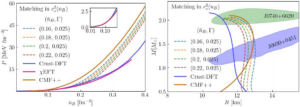 Date: March 05, 2025
Date: March 05, 2025
Title: Building Neutron Stars with the MUSES Calculation Engine
Authors: Mateus Reinke Pelicer, Nikolas Cruz-Camacho, Carlos Conde-Ocazionez, David Friedenberg, Satyajit Roy, Ziyuan Zhang, T. Andrew Manning, Mark G. Alford, Alexander Clevinger, Joaquin Grefa, Roland Haas, Alexander Haber, Mauricio Hippert, Jeremy W. Holt, Johannes Jahan, Micheal Kahangirwe, Rajesh Kumar, Jeffrey Peterson, Hitansh Shah, Andrew W. Steiner, Hung Tan, Yumu Yang, Volodymyr Vovchenko, Veronica Dexheimer, Jorge Noronha, Jaquelyn Noronha-Hostler, Claudia Ratti, Nicolás Yunes
Abstract: Exploring the equation of state of dense matter is an essential part of interpreting the observable properties of neutron stars. We present here the first results for dense matter in the zero-temperature limit generated by the MUSES Calculation Engine, a composable workflow management system that orchestrates calculation and data processing stages comprising a collection of software modules designed within the MUSES framework. The modules presented in this work calculate equations of state using algorithms spanning three different theories/models: (1) Crust Density Functional Theory, valid starting at low densities, (2) Chiral Effective Field Theory, valid around saturation density, and (3) the Chiral Mean Field model, valid beyond saturation density. Lepton contributions are added through the Lepton module to each equation of state, ensuring charge neutrality and the possibility of β-equilibrium. Using the Synthesis module, we match the three equations of state using different thermodynamic variables and different methods. We then couple the complete equation of state to a novel full-general-relativity solver (QLIMR) module that calculates neutron star properties. We find that the matching performed using different thermodynamic variables affects differently the range obtained for neutron star masses and radii (although never beyond a few percent difference). We also investigate the universality of equation of state-independent relations for our matched stars. Finally, for the first time, we use the Flavor Equilibration module to estimate bulk viscosity and flavor relaxation charge fraction and rates (at low temperature) for Chiral Effective Field Theory and the Chiral Mean Field model. - Modern nuclear and astrophysical constraints of dense matter in a redefined chiral approach
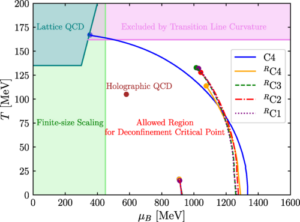 Published on April 01, 2024
Published on April 01, 2024
Title: Modern nuclear and astrophysical constraints of dense matter in a redefined chiral approach
Authors: Rajesh Kumar, Yuhan Wang, Nikolas Cruz Camacho, Arvind Kumar, Jacquelyn Noronha-Hostler, Veronica Dexheimer
Abstract: We explore the quantum chromodynamics (QCD) phase diagram’s complexities, including quark deconfinement transitions, liquid-gas phase changes, and critical points by using the chiral mean-field (CMF) model that is able to capture all these features. We introduce a vector meson field redefinition within the CMF framework, enabling precise adjustments of meson masses and coupling strengths related to vector meson interactions. Performing a new fit to the deconfinement potential, we are able to replicate recent lattice QCD results, low-energy nuclear physics properties, neutron star observational data, and key phase diagram features as per modern constraints. This approach enhances our understanding of vector mesons’ roles in mediating nuclear interactions and their impact on the equation of state, contributing to a more comprehensive understanding of the QCD phase diagram and its implications for nuclear and astrophysical phenomena.
- Hot QCD phase diagram from holographic Einstein–Maxwell–Dilaton modelsDate: November 30, 2023
Title: Hot QCD phase diagram from holographic Einstein–Maxwell–Dilaton models Authors: Romulo Rougemont, Joaquin Grefa, Mauricio Hippert, Jorge Noronha, Jacquelyn Noronha-Hostler, Israel Portillo, Claudia Ratti
Abstract: In this review, we provide an up-to-date account of quantitative bottom-up holographic descriptions of the strongly coupled quark–gluon plasma (QGP) produced in relativistic heavy-ion collisions, based on the class of gauge-gravity Einstein–Maxwell–Dilaton (EMD) effective models. The holographic approach is employed to tentatively map the QCD phase diagram at finite temperature onto a dual theory of charged, asymptotically Anti-de Sitter (AdS) black holes living in five dimensions. With a quantitative focus on the hot QCD phase diagram, the nonconformal holographic EMD models reviewed here are adjusted to describe first-principles lattice results for the finite-temperature QCD equation of state, with 2+1 flavors and physical quark masses, at zero chemical potential and vanishing electromagnetic fields. We review the evolution of such effective models and the corresponding improvements produced in quantitative holographic descriptions of the deconfined hot QGP phase of QCD. The predictive power of holographic EMD models is tested by quantitatively comparing their predictions for the hot QCD equation of state at nonzero baryon density and the corresponding state-of-the-art lattice QCD results. Hydrodynamic transport coefficients such as the shear and bulk viscosities predicted by these EMD constructions are also compared to the corresponding profiles favored by the latest phenomenological multistage models simultaneously describing different types of heavy-ion data. We briefly report preliminary results from a Bayesian analysis using EMD models, which provide systematic evidence that lattice QCD results at finite temperature and zero baryon density strongly constrains the free parameters of such bottom-up holographic constructions. Remarkably, the set of parameters constrained by lattice results at vanishing chemical potential turns out to produce EMD models in quantitative agreement with lattice QCD results also at finite baryon density. We also review results for equilibrium and transport properties from magnetic EMD models, which effectively describe the hot and magnetized QGP at finite temperatures and magnetic fields with zero chemical potentials. Finally, we provide a critical assessment of the main limitations and drawbacks of the holographic models reviewed in the present work, and point out some perspectives we believe are of fundamental importance for future developments. - Bayesian location of the QCD critical point from a holographic perspective
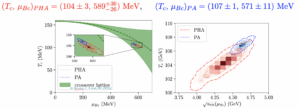 Date: September 1, 2023
Date: September 1, 2023
Title: Bayesian location of the QCD critical point from a holographic perspective
Authors: Mauricio Hippert, Joaquin Grefa, T. Andrew Manning, Jorge Noronha, Jacquelyn Noronha-Hostler, Israel Portillo Vazquez, Claudia Ratti, Romulo Rougemont, Michael Trujillo
Abstract: A fundamental question in QCD is the existence of a phase transition at large doping of quarks over antiquarks. We present the first prediction of a QCD critical point (CP) from a Bayesian analysis constrained by first principle results at zero doping. We employ the gauge/gravity duality to map QCD onto a theory of dual black holes. Predictions for the CP location in different realizations of the model overlap at one sigma. Even if many prior samples do not include a CP, one is found in nearly 100% of posterior samples, indicating a strong preference for a CP. - Finite density QCD equation of state: critical point and lattice-based T′-expansion
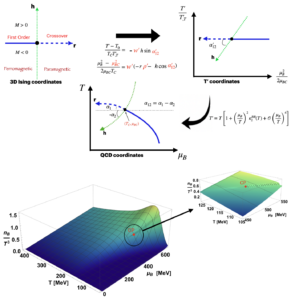 Date: February 13, 2024
Date: February 13, 2024
Title: Finite density QCD equation of state: critical point and lattice-based T′-expansion
Authors: Micheal Kahangirwe, Steffen A. Bass, Elena Bratkovskaya, Johannes Jahan, Pierre Moreau, Paolo Parotto, Damien Price, Claudia Ratti, Olga Soloveva, Mikhail Stephanov
Abstract: We present a novel construction of the QCD equation of state (EoS) at finite baryon density. Our work combines a recently proposed resummation scheme for lattice QCD results with the universal critical behavior at the QCD critical point. This allows us to obtain a family of equations of state in the range 0≤μB≤700 MeV and 25≤T≤800 MeV, which match lattice QCD results near μB=0 while featuring a critical point in the 3D Ising model universality class… - Thermodynamics of an updated hadronic resonance list and influence on hadronic transport
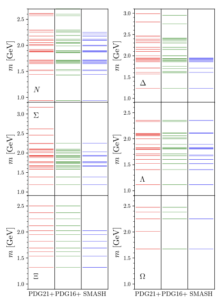 Date: Sep 04, 2023
Date: Sep 04, 2023
Title: Thermodynamics of an updated hadronic resonance list and influence on hadronic transport
Authors: Jordi Salinas San Martín, Renan Hirayama, Jan Hammelmann, Jamie M. Karthein, Paolo Parotto, Jacquelyn Noronha-Hostler, Claudia Ratti, Hannah Elfner
Abstract: Hadron lists based on experimental studies summarized by the Particle Data Group (PDG) are a crucial input for the equation of state and thermal models used in the study of strongly-interacting matter produced in heavy-ion collisions. Modeling of these strongly-interacting systems is carried out via hydrodynamical simulations, which are followed by hadronic transport codes that also require a hadronic list as input. To remain consistent throughout the different stages of modeling of a heavy-ion collision, the same hadron list with its corresponding decays must be used at each step. It has been shown that even the most uncertain states listed in the PDG from 2016 are required to reproduce partial pressures and susceptibilities from Lattice Quantum Chromodynamics with the hadronic list known as the PDG2016+. Here, we update the hadronic list for use in heavy-ion collision modeling by including the latest experimental information for all states listed in the Particle Data Booklet in 2021. We then compare our new list, called PDG2021+, to Lattice Quantum Chromodynamics results and find that it achieves even better agreement with the first principles calculations than the PDG2016+ list. Furthermore, we develop a novel scheme based on intermediate decay channels that allows for only binary decays, such that PDG2021+ will be compatible with the hadronic transport framework SMASH. Finally, we use these results to make comparisons to experimental data and discuss the impact on particle yields and spectra. - Theoretical and Experimental Constraints for the Equation of State of Dense and Hot Matter
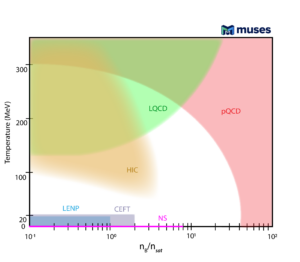 Published on June 05, 2024
Published on June 05, 2024
Title: Theoretical and Experimental Constraints for the Equation of State of Dense and Hot Matter
Authors: Rajesh Kumar, Veronica Dexheimer, Johannes Jahan, Jorge Noronha, Jacquelyn Noronha-Hostler, Claudia Ratti, Nico Yunes, Angel Rodrigo Nava Acuna, Mark Alford, Mahmudul Hasan Anik, Debarati Chatterjee, Katerina Chatziioannou, Hsin-Yu Chen, Alexander Clevinger, Carlos Conde, Nikolas Cruz-Camacho, Travis Dore, Christian Drischler, Hannah Elfner, Reed Essick, David Friedenberg, Suprovo Ghosh, Joaquin Grefa, Roland Haas, Alexander Haber, Jan Hammelmann, Steven Harris, Carl-Johan Haster, Tetsuo Hatsuda, Mauricio Hippert, Renan Hirayama, Jeremy W. Holt, Micheal Kahangirwe, Jamie Karthein, Toru Kojo, Philippe Landry, Zidu Lin, Matthew Luzum, Timothy Andrew Manning, Jordi Salinas San Martin, Cole Miller, Elias Roland Most, Debora Mroczek, Azwinndini Muronga, Nicolas Patino, Jeffrey Peterson, Christopher Plumberg, Damien Price, Constanca Providencia, Romulo Rougemont, Satyajit Roy, Hitansh Shah, Stuart Shapiro, Andrew W. Steiner, Michael Strickland, Hung Tan, Hajime Togashi, Israel Portillo Vazquez, Pengsheng Wen, Ziyuan Zhang (MUSES Collaboration)
Abstract: This review aims at providing an extensive discussion of modern constraints relevant for dense and hot strongly interacting matter. It includes theoretical first-principle results from lattice and perturbative QCD, as well as chiral effective field theory results. From the experimental side, it includes heavy-ion collision and low-energy nuclear physics results, as well as observations from neutron stars and their mergers. The validity of different constraints, concerning specific conditions and ranges of applicability, is also provided.
- Resummed lattice QCD equation of state at finite baryon density: strangeness neutrality and beyond
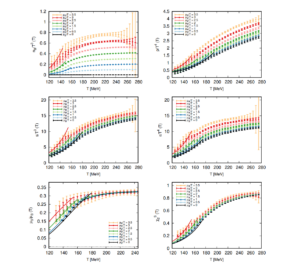 Date: February 11, 2022
Date: February 11, 2022
Title: Resummed lattice QCD equation of state at finite baryon density: strangeness neutrality and beyond
Authors: Szabolcs Borsanyi, Zoltan Fodor, Jana N. Guenther, Ruben Kara, Paolo Parotto, Attila Pasztor, Claudia Ratti, Kalman K. Szabo
Abstract: This work presents a generalization of the scheme introduced in 2102.06660 to the case of non-zero μS, focusing on the line of strangeness neutrality. We present results up to μB/T≤3.5 on the strangeness neutral line ⟨S⟩=0 in the temperature range 130 MeV≤T≤280 MeV. We also extrapolate the finite baryon density equation of state to small non-zero values of the strangeness-to-baryon ratio R=⟨S⟩/⟨B⟩. We perform a continuum extrapolation using lattice simulations of the 4stout-improved staggered action with 8, 10, 12 and 16 timeslices.


